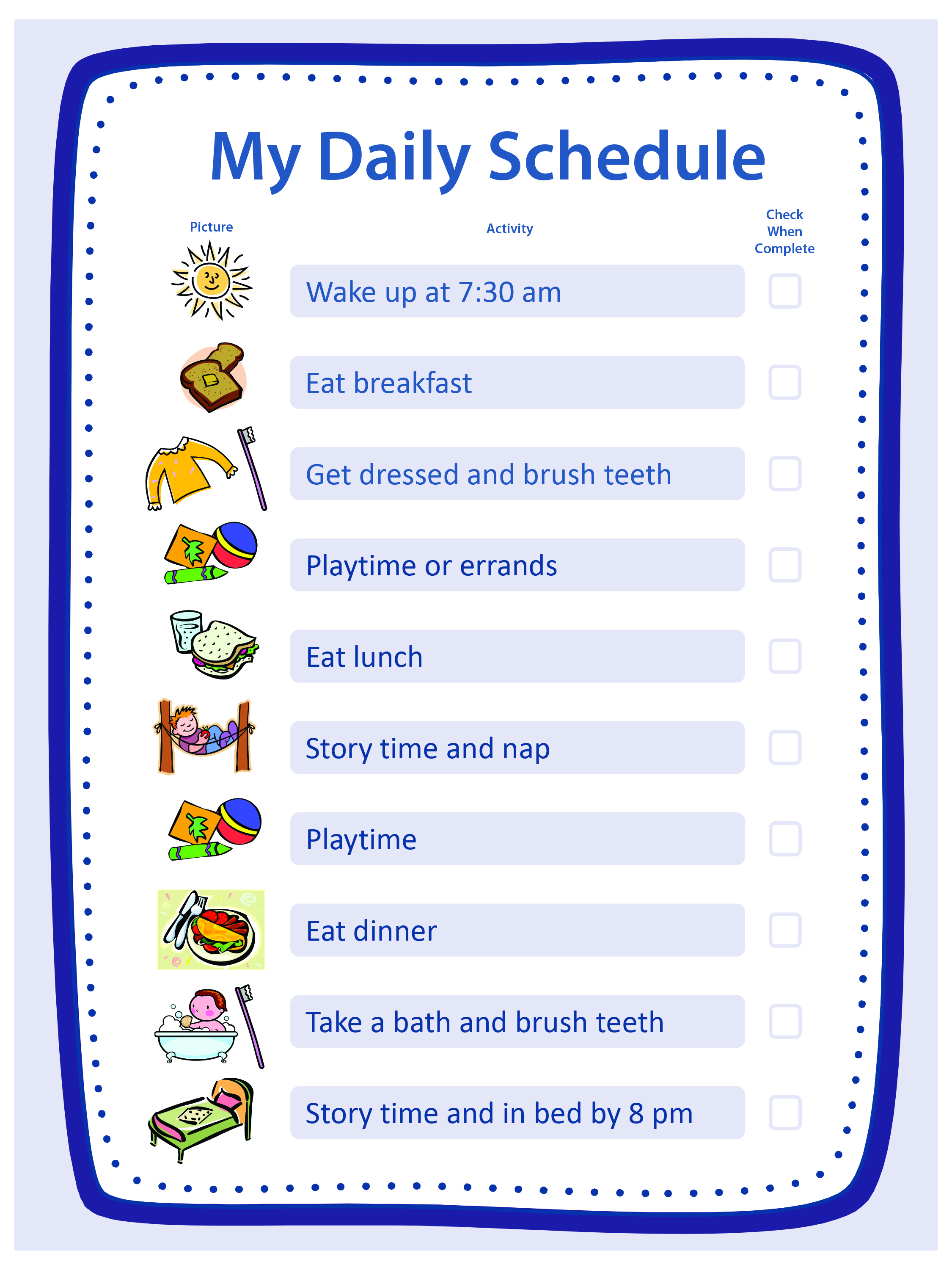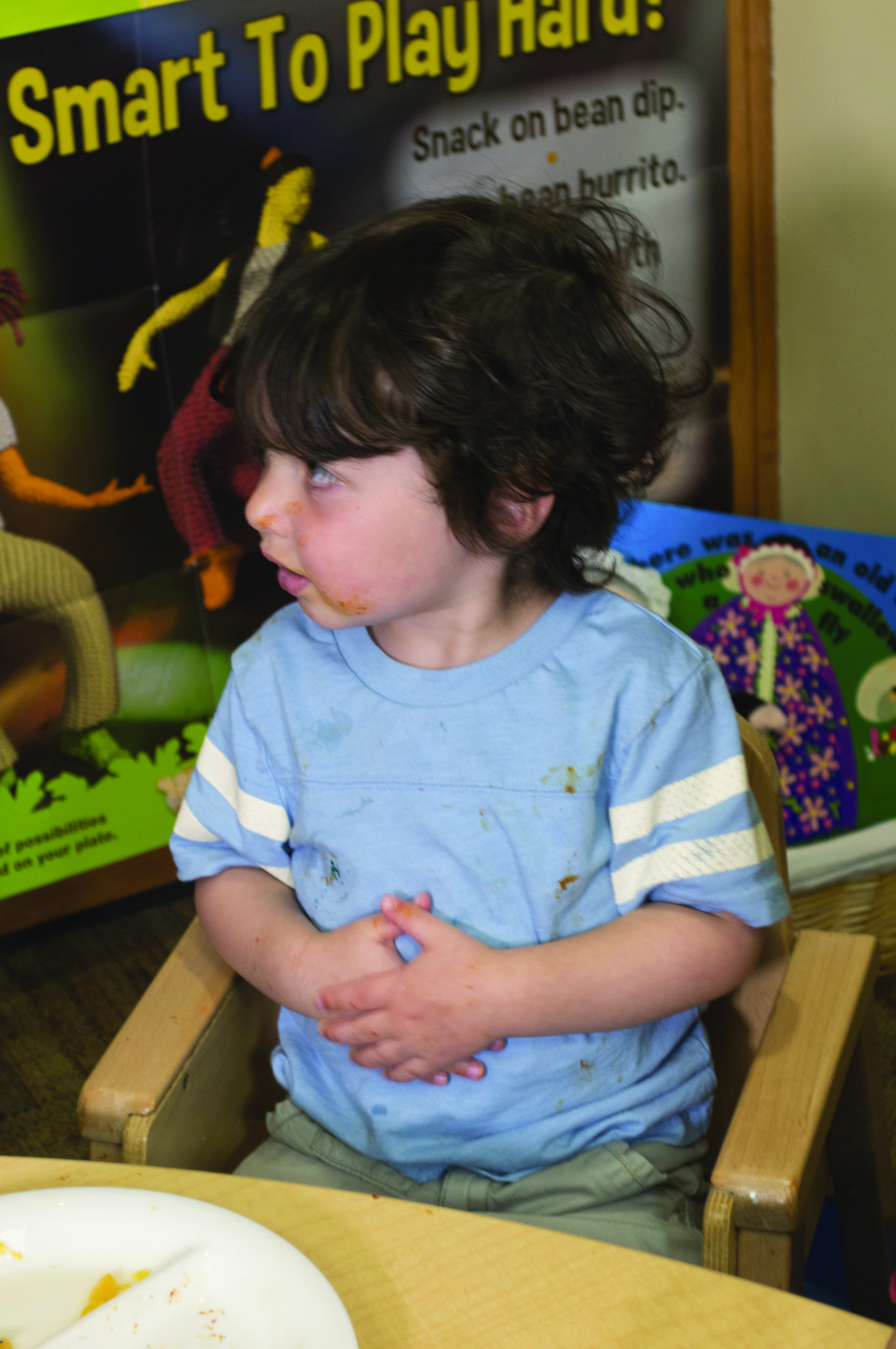

Aileen S. Garcia, Extension Research Graduate Assistant
Zahra A. Aldekhel, Extension Research Undergraduate Assistant
Dipti A. Dev, Assistant Professor and Child Health Behaviors Extension Specialist
Jaclynn J. Foged, Extension Educator
Gina M. Kunz, Research Associate Professor, Nebraska Center for Research on Children, Youth, Families and Schools
Parents and caregivers of children on the autism spectrum often experience challenges in feeding their children and promoting healthy eating. The objective of this guide is to provide science-based information and practical guidance to caregivers regarding how to support children with autism who are facing feeding challenges during mealtime.
Autism Spectrum Disorder (ASD) is a neurological condition that is typically characterized by deficits in communication and social interaction, and accompanied by restricted or repetitive behaviors. According to the fifth edition of the Diagnostic and Statistical Manual of Mental Disorders, the main characteristics of autism include deficiencies in social communications and understanding relationships with others. In addition, children with autism tend to have restricted and repetitive patterns of behavior, activities, and highly fixated interests. This means that their behavior is inflexibly linked to routine and is usually ritualized. For example, a child who is expecting the regular teacher in the classroom may feel anxious and distraught when there is a substitute teacher. Or, a child who is used to eating chicken cooked in a certain way may refuse to eat and inappropriately fuss over a chicken meal that looks different.
The prevalence of children diagnosed with autism has dramatically increased from less than 1 percent in the year 2000 to 1.5 percent in 2010. According to Autism Speaks, about one in 68 children (one in 42 boys and one in 189 girls) is diagnosed with ASD. Research finds that children with ASD are five times more likely to develop persistent feeding problems compared with their typically developing peers. Food selectivity–wanting only certain types of food–is found to be the most noted feeding challenge among children with ASD. The growing number of children being diagnosed with ASD and the higher prevalence of chronic feeding problems in this population warrant the need for interventions and tools to help parents and other caregivers in providing adequate nutrition and supporting children’s healthy eating. To do this, we must first recognize the challenges parents of children with autism might face regarding mealtime and feeding.

Many caregivers experience different challenges in raising their children with autism, including difficulties around feeding. Children with autism have been described as having limited food preferences and “picky” eating habits. These conditions make it more challenging for caregivers to ensure that these children eat well and have a nutritionally balanced diet. Below are additional challenges children with autism and their families may face:
Finding solutions to mealtime challenges for children with autism is as varied as the potential challenges presented; there is not one solution. As mentioned, autism is a type of spectrum disorder. This means that each child will experience different challenges and will respond differently to intervention strategies. Thus, different solutions will need to be applied to different cases. The following strategies may help parents have better feeding experiences with their children:
One consistent theme in food selectivity relates to food textures. It is possible that sensory sensitivity experienced by children with ASD may add to their difficulty with food texture and food selectivity. The following are some potential solutions for texture sensitivities:
Gradually introducing a child to a new food can expand diet variety, and parents are encouraged to involve the child in the food selection process. The website ChooseMyPlate.gov from the U.S. Department of Agriculture (USDA) suggests that when assembling a meal, there should be choices of healthy foods from all five food groups: grains, protein, fruits, vegetables, and dairy. When eating a healthy, balanced meal becomes part of the child’s routine, it will help establish a foundation for safe and healthy eating behaviors and increase the predictability that children with autism like.
Typically developing children may have to try a new food 10 or more times over several months before deciding whether they like it. A child with ASD likely will take considerably longer to gain familiarity with a particular food due to the new experiences that come with the action (e.g., new taste, smell, image, etc.). The most important points to remember when introducing new foods are to be patient and to determine what the child enjoys and dislikes. Avoid introducing too many foods at once, which might overwhelm the child. Take into account “the rule of 3,” which means offering only three foods at a time—two that the child already likes, and one that the child has not tried or did not like before.
If the child refuses to try a certain food, keep offering different foods. It is best to avoid spending a lot of time on a food that the child does not like, particularly if the rejection comes from smell or texture as opposed to just taste. In addition to taste, texture and smell are important for children with autism. For example, if the child likes the texture of a raw apple, try introducing cooked apple. If the child accepts cooked apple, then introduce cooked potato, as they have similar textures. Keep notes on what and how much the child eats, as well as refuses to eat, at mealtime. Make notes of strategies used and the child’s behavior during mealtimes. Refer to these notes to continue offering foods that the child eats and to use strategies that work. These notes might also be helpful when seeking guidance from primary care physicians.
Caregivers can simultaneously present a preferred and non-preferred food to increase the range of food that children eat. For example, small bits of broccoli can be mixed in the child’s favorite soup.

As mentioned, children with autism tend to engage in repetitive behaviors. Rather than attempting to correct these behaviors by only removing undesirable habits, parents should establish new practices that are more beneficial. This can be accomplished by having a specific place for meals, such as a child-sized table or high chair, and consistent times for meals every day. Further, a statement such as “It’s time to eat” or a brief song could signal that it is mealtime. This could help with the transition from another activity to a meal. Mealtime could begin with a bite or two of preferred food to encourage eating immediately, followed by non-preferred foods as explained in suggestions 3 or 4, and then offer another bite or two of preferred food to encourage meal completion. Conclude with access to a preferred activity or choices of preferred activities (e.g. reading a book, drawing, coloring or going for a walk, playing a game) to reinforce eating a meal.

Positive reinforcement is crucial to feeding time and is important for encouraging the mealtime behaviors we want to see. When a child tries new food, offer specific praise. For example, a parent could say, “Sarah, I like how you just tried that piece of broccoli!” Being specific helps children understand what we liked that they did, and increases the chance they will engage in that behavior again to gain our positive attention. Rewarding them with extra time on activities that they enjoy, such as playing educational games on the computer or a tablet after they have tried new foods, could also help encourage more of that behavior.

A good recommendation is to keep mealtime comfortable and supportive. Specifically, try using a high chair or child-sized table to ensure that the child is comfortable during mealtime. Keep distractions minimal, such as turning off the television or setting the toys aside while eating.

Even if some children with autism are classified as “nonspeaking” due to language delays, they still use some types of sounds, speech, or nonverbal communication for certain purposes. In these cases, research supports the use of Augmented and Alternative Communication (AAC) to help children convey their thoughts and emotions. AAC can vary from hand gestures (such as pointing), signs, pictures, and alternative communication devices. Parents and caregivers might worry that AAC will reduce the child’s motivation to speak, but there is significant evidence to suggest the opposite.
Research has shown that AAC does not interfere with speech; rather, it increases the child’s ability to learn speech. Using AAC also advances children’s communication skills because it gives them as much control as possible, allowing them the freedom to express themselves more accurately and more quickly. For example, during feeding time, a child might point at something to indicate that he or she wants to know what it is, but is struggling to find a word for it. Caregivers can help by verbalizing and labeling the items. This way, children will learn the right words and use them in conversation. Also, different hand gestures can mean different things with practice. For example, having children put their hands on their tummy can signify they are hungry or would like some more, while crossing both arms can mean full or stop.
Alternatively, caregivers might use flash cards and print pictures of healthy foods from which children could select the food they like to eat. This link from the National Heart, Lung, and Blood Institute includes pictures of different foods, as well as guidance to teach children about healthy and unhealthy foods: https://www.nhlbi.nih.gov/health/educational/wecan/downloads/gswflashcards.pdf
If the child likes using tablets or smartphones, there are many apps that can be downloaded and used for communication. Simply search “AAC Communicator” online to see the listing of apps, their ratings, and reviews. Free apps such as LetMeTalk, CoughDrop, and JABTAlk are great examples based on their diverse range of pictures and symbols. It is important to note, however, that the AAC strategy is not meant to replace verbal speech and should only be used as a tool to bridge nonverbal and speech communication.

There are also strategies outside of mealtimes that can improve the mealtime experience.
Eighty percent of children with autism experience sleeping problems. Sleeping is a very important aspect of human functioning, and lack of sleep can cause irritability, slowed development, slowed cognition, fatigue, and might also cause gastrointestinal disturbances. The cause of sleeping difficulties among children with autism is not very well understood, but there are strategies to help regulate a child’s sleeping schedule.

Instead of providing three large meals, as is typical, smaller and more frequent portions with five to six scheduled meals and snacks may be provided for children with autism. This way, their intake is spread throughout the day, and they may feel full and less irritable. Additionally, if the child rejects a specific food, it is only a small amount that is rejected instead of an entire meal. However, it is important to set a schedule to offer the frequent meals and snacks and avoid all day snacking.
Be a positive role model by leading the way with all activities. When introducing a meal, eat it with them and say something positive about the food. For example, parents could say that they like the texture of the food in their mouth, or that they are really enjoying the food’s savory taste. Children tend to imitate adults who are around them, so it is important to show positive behaviors for them to model. If the child has older siblings, try to get them involved with being a positive role model as well.

Raising a child with autism requires a lot of patience, preparation, and intentionality, especially considering the challenges with routines, such as the ones outlined in this article related to eating. Research has shown mothers of young children diagnosed with autism are more likely to experience stress and depressive symptoms than mothers raising typically developing children. There are numerous benefits when fathers participate actively in caregiving activities with their children, such as reading books, singing songs, bathing, feeding, or responding to the child’s cry. Father’s involvement can boost mom’s mental health, reduce stress, and promote the child’s ability to learn new words and communicate. Parents can also seek additional support from other caregivers (e.g., child care providers, teachers, other family members). Research has shown that caregivers who are more coordinated and less conflicted during mealtime experience reduced stress and fewer disruptive mealtime behaviors. Therefore, it is critical that parents and caregivers discuss their approach and practices for feeding children to prevent conflicts at mealtime and to have agreed-upon strategies to address conflicts. Be open to new ideas and try a wide variety of strategies to find what works best for oneself, the child, and the family.
In this article, we discussed some of the challenges that children with autism and their parents typically face regarding the difficulties of mealtime. We also outlined strategies and solutions to common mealtime issues. However, we must remember that there is no one-size-fits-all approach to feeding children with autism. Since autism occurs on a spectrum, there are different levels and severities of autism. Therefore, we implement different strategies that are sensitive and responsive to the child’s specific needs. The key is to be patient, supportive, and open-minded in trying and implementing strategies that can help promote a positive and healthy mealtime experience of the children and the family.
Below are additional resources that provide information on feeding children with autism:
Online applications for smartphones and tablets such as LetMeTalk, CoughDrop, and JABTAlk
Autism Speaks Autism Treatment Network (2014). Parent’s Guide to Exploring Feeding Behavior in Autism presented by Autism Speaks ATN/AIR-P.
https://www.autismspeaks.org/sites/default/files/docs/sciencedocs/atn/feeding_guide.pdf
Chen, I. (2015). Wide Awake: Why Children with Autism Struggle with Sleep. https://spectrumnews.org/features/deep-dive/wide-awake-why-children-with-autism-struggle-with-sleep/
Nath, S. (2016). Feeding Problems in Children with Autism. Interactive Autism Network at Kennedy Krieger Institute.
https://iancommunity.org/ssc/feeding-problems-children-autism
U.S. Department of Health and Human Services, National Heart, Lung and Blood Institute. (2013). We can! Go, Slow, and Whoa foods. https://www.nhlbi.nih.gov/health/educational/wecan/downloads/gswflashcards.pdf
Wheeler, M. (2004). Mealtime and Children on the Autism Spectrum: Beyond Picky, Fussy, and Fads.
American Psychological Association. Diagnostic and Statistical Manual of Mental Disorders. Fifth Edition. Arlington, VA: American Psychiatric Publishing; 2013.
Twachtman-Reilly J, Amaral SC, Zebrowski PP. Addressing feeding disorders in children on the autism spectrum in school-based settings: physiological and behavioral issues. Lang Speech Hear Serv Sch. 2008;39(2):261–272. doi:10.1044/0161-1461(2008/025).
Christensen DL, Baio J, Braun KV, et al. Prevalence and Characteristics of Autism Spectrum Disorder Among Children Aged 8 Years—Autism and Developmental Disabilities Monitoring Network, 11 Sites, United States, 2012. MMWR Surveill Summ 2016;65(No. SS-3)(No. SS-3):1–23. doi: http://dx.doi.org/10.15585/mmwr.ss6503a1
Sharp W, Berry RC, Cole-Clark M, Criado KK, McElhanon BO. Assessment of feeding disorders in ASD: A multidisciplinary approach. In: Matson JL, ed. Handbook of Assessment and Diagnosis of Autism Spectrum Disorder. Switzerland: Springer International Publishing; 2016:315–335. doi:10.1007/978-3-319-27171-2.
Rogers LG, Magill-Evans J, Rempel GR. Mothers’ challenges in feeding children with autism spectrum disorder - Managing more than just picky eating. J Dev Phys Disabil. 2012;24(1):19–33. doi:10.1007/s10882–011–9252–2.
Matson JL, Fodstad JC. The treatment of food selectivity and other feeding problems in children with autism spectrum disorders. Res Autism Spectr Disord. 2009;3(2):455–461. doi:10.1016/j.rasd.2008.09.005.
Cermak S, Curtin C, Bandini L. Food selectivity and oral sensitivity in children with autism spectrum disorders. J Am Diet Assoc. 2010;110(2):238–246. doi:10.1016/j.jada.2009.10.032.Food.
Amminger GP, Berger GE, Schäfer MR, Klier C, Friedrich MH, Feucht M. Omega-3 fatty acids supplementation in children with autism: A double-blind randomized, placebo-controlled pilot study. Biol Psychiatry. 2007;61(4):551–553. doi:10.1016/j.biopsych.2006.05.007.
Denny S. What are Omega-3 fatty acids? http://www.eatright.org/resource/food/vitamins-and-supplements/types-of-vitamins-and-nutrients/what-are-omega-3-fatty-acids. Published 2015. Accessed January 30, 2017.
Parker-Pope T. 6 food mistakes parents make. 2014;(September). http://www.nytimes.com/2008/09/15/health/healthspecial2/15eat.html.
Autism Speaks. Exploring Feeding Behavior in Autism.; 2014. http://www.airpnetwork.org/atf/cf/%7B21E91B8F-D0F9–424E-8242-C281E1B81562%7D/Feeding Behavior Guide.pdf.
Nath S. Feeding problems in children with autism picky eating or feeding disorder? Interventions for problem behaviors in autism gastrointestinal problems in ASD. Interact Autism Netw. 2014:1–6.
Cress CJ. Responding to a common early AAC Question: “Will my child talk?” AHSA SID Newsl. 2003;12:10–11. doi:10.1044/aac12.5.10.
Ganz JB, Simpson RL. Effects on communicative requesting and speech development of the picture exchange communication system in children with characteristics of autism. J Autism Dev Disord. 2004;34(4):395–409. doi:10.1023/B:JADD.0000037416.59095.d7.
Ali T, Choe J, Awab A, Wagener TL, Orr WC. Sleep, immunity and inflammation in gastrointestinal disorders. World J Gastroenterol. 2013;19(48):9231–9239. doi:10.3748/wjg.v19.i48.9231.
Jeans LM, Santos RM, Laxman DJ, McBride B a., Dyer WJ. Examining ECLS-B: Maternal stress and depressive symptoms when raising children with ASD. Topics Early Child Spec Educ. 2013;33(3):162–171. doi:10.1177/0271121413481680.
Laxman DJ, McBride BA, Jeans LM, et al. Father involvement and maternal depressive symptoms in families of children with disabilities or delays. Matern Child Health J. 2015;19(5):1078–1086. doi:10.1007/s10995-014-1608-7.
Thullen M, Bonsall A. Co-parenting quality, parenting stress, and feeding challenges in families with a child diagnosed with Autism Spectrum Disorder. J Autism Dev Disord. 2017:1–8.
Nebraska Extension publications are availableonline at http://extensionpubs.unl.edu/.
Extension is a Division of the Institute of Agriculture and Natural Resources at the University of Nebraska–Lincoln cooperating with the Counties and the United States Department of Agriculture.
Nebraska Extension educational programs abide with the nondiscrimination policies of the University of Nebraska–Lincoln and the United States Department of Agriculture.
© 2017, The Board of Regents of the University of Nebraska on behalf of the University of Nebraska–Lincoln Extension. All rights reserved.